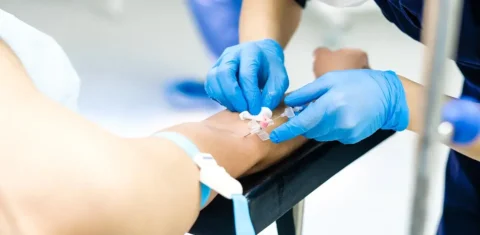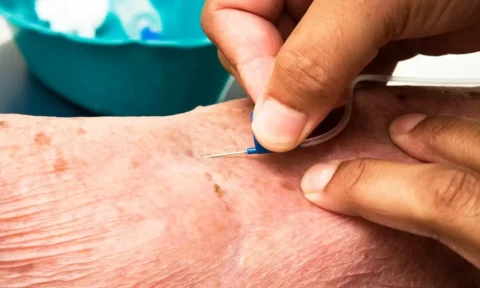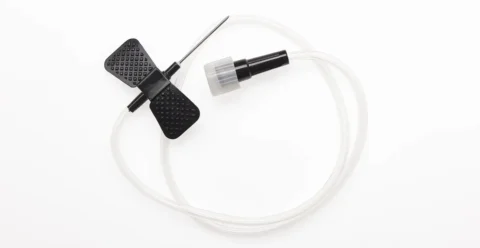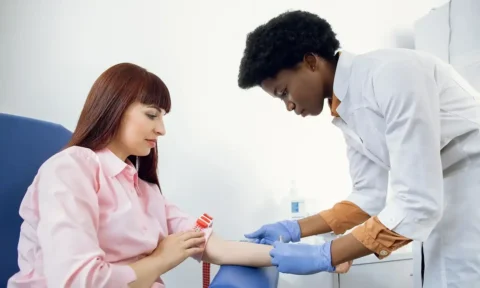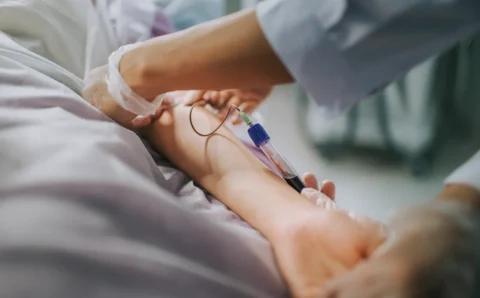Syringes and needles are some of the most commonly used medical equipment because doctors and nurses need them for blood draw, medication delivery, IV therapy, and more. Since they play a huge role in the medical industry, healthcare practitioners must know what their difference is, as well as the best use for each needle size.
So what’s the difference between a 22-gauge needle size and a butterfly needle? A higher needle gauge means a smaller hole. Butterfly needle systems come as units that include a hypodermic needle gauge range of 18-gauge to 27-gauge depending on their intended use, but a 22-gauge straight needle is mainly used for blood collection from older children and adults with medium-sized veins.
The Size Difference Between 22-Gauge Needles and Butterfly Needles
Needles come in various lengths and gauges that have their own recommended use. The gauge of a needle refers to the size of the hole in it – the higher a needle’s gauge is, the smaller the hole is. On the other hand, the needle length is listed on the label after the gauge number. For example, 22G ½ is a 22-gauge needle that’s a half-inch long.
Longer needles that are at least ½ inch are used for intramuscular injection, but shorter needles that are ½ inch at most are for intravenous injection. Different needle sizes (gauges and lengths) have different uses, so it’s important for healthcare professionals to know how to utilize them correctly.
Butterfly needles are available in different gauges, but the most common ones use 23-gauge needles to puncture smaller veins without injuring them or causing hemolysis (destruction of blood cells). They’re a bit smaller than the 22-gauge blood collection needle attached to a syringe or tube holder.
But this doesn’t mean one should be used more often than the other – it still depends on the purpose, as well as the vein size of the patient.
22-Gauge Needles and Their Uses
The 22-gauge safety needle is somewhere between the 21-gauge and 23-gauge size. Depending on the healthcare facility, staff may use this smaller needle for a routine blood draw on older children or adult patients with medium-sized veins. The idea for using 22-gauge needles is to perform venipuncture on smaller veins that won’t fit a 21-gauge larger needle and bigger veins that aren’t ideal for 23-gauge needles.
1. What They Look Like
A 22-gauge needle looks like a regular needle that can be assembled with most multi-sample needle ETS systems. It may also have a black color code covering to easily tell it apart from other needles of the same length.
To check the gauge size and length, look for the listed label of the needle – it should say “22G” along with the needle length of your choice. Make sure to use a sterile 22-gauge needle of the right length before putting it in the needle holder and attaching it to a syringe or collection tube.
2. What They’re Used For
Healthcare professionals often use 22-gauge needles for routine blood collection and short-term IV injection or therapy. While it’s a thinner needle than the 21-gauge one, it’s still strong enough to be used for intramuscular injections as long as the length used is longer than ½ inch. Some physicians also prefer using this safety blood collection needle for collecting sample tissues needed for biopsy.
3. Advantages of the 22-Gauge Needle
- Glides easily into the skin for less discomfort
- Easy venous access for medium-sized veins of older children and other adults
- Can easily be assembled with a common multi-sample needle ETS system
- Allows collection of multiple blood specimen
- Higher-quality quality of venous blood sample
- Lower chances of needle stick injuries
4. Disadvantages of the 22-Gauge Needle
- Slower venous blood flow than 21-gauge needles when filling the collection tube
- Not recommended for extremely tiny veins in younger children and infants
Butterfly Needle Sizes and Their Uses
Butterfly needles are medical devices usually used for drawing blood from and delivering IV therapy to the veins. Each butterfly needle is attached to transparent tubing and a connector. It has 2 plastic wings that make it look like a Huber needle, but the main difference between the two is that Huber needles are bent at a 90° angle.
Aside from their distinguishable appearance, butterfly needles also come in different needle sizes (from 18-gauge to 27-gauge) that are used for different purposes. Butterfly needles have color-coded wings to make it easier for medical professionals to tell them apart.
1. What Color is a 21-Gauge Butterfly Needle?
A 21-gauge butterfly needle comes with green-colored wings to differentiate it from other needle sizes. It’s usually utilized for drawing blood samples from patients with thin or shallow veins. Its gauge is small enough that it won’t cause significant discomfort or pain for the patient while collecting blood or administering medications.
2. What Size Gauge Butterfly Needle is Needed for Glutathione IV Push?
Glutathione IV push treatments are best administered using a 23-gauge (with light blue wings) or 25-gauge (with orange wings) butterfly IV needle or catheter. The entire treatment session takes around 20 minutes and it’s best repeated twice per week in either of the patient’s arms to help them achieve the best results.
3. Advantages of Using Butterfly Needles
- Allows precise needle placement, especially for veins that are difficult to access
- Easier access for superficial veins
- A lot less painful for most patients
- Can be inserted into tiny veins found in the hand, heel, foot, or scalp
- Ideal for people with rolling or spastic veins
- Less likely to cause nerve injury, vein collapse, or profuse bleeding
4. Disadvantages of Using Butterfly Needles
- Slower blood collection than other needles
- Not recommended for urgent situations or for patients who feel squeamish during a blood draw
- May damage the vein if the butterfly needle is suddenly yanked
Other Common Needle Sizes and Their Uses
Remembering the difference between various needle sizes is crucial because there’s no one gauge size for phlebotomy patients. Each needle has a different blood flow rate and vein type compatibility with the others. Aside from 22-gauge straight needles and butterfly needle sets, here are other common needles sizes every healthcare professional should know about:
1. 18-Gauge Needle
An 18-gauge needle isn’t recommended for routine blood draws, but it’s best used for a blood donation or therapeutic phlebotomy. Because of its size, the 18-gauge needle is ideal for drawing substantial amounts of blood that require a quick flow rate. It also comes attached to collection bags so it won’t need additional assembly.
2. 21-Gauge Needle
The 21-gauge needle is the most commonly used needle size for venipuncture and routine blood draws. It’s small enough to not cause discomfort during use but large enough to collect blood more quickly than 22-gauge needles. Most patients and vein types are suitable for 21-gauge needles.
Buy the Best Needles and Medical Equipment from FACE Med Store
When it comes to choosing the best needles for venipuncture and other medical purposes, it’s important to consider the needle size as well as the size of the vein. Butterfly needle sets are meant for smaller veins while 22-gauge needles are for medium-sized veins of older children and some adults.
And if you need a supplier to provide you with the best butterfly and straight needle sets, then look no further than FACE Med Store. We’re the trusted partner of hundreds of healthcare practitioners around the country, so you can rely on us when it comes to high-quality medical equipment and more.
Call us today to know more about our needle sets and other products.
